The post All about Japanese teas first appeared on Blog Royal Tips.
]]>- Most of the teas are mechanically picked using hand-held hedge trimmer type machines or ride-on harvesting machines.
- The tea producers do not sort their tea at the end of the process; instead they sell the unsorted tea, known as ‘aracha’, to wholesalers who sort all the large batches of the teas they buy into different types which are then sold to retail outlets or international buyers.
- Teas are sold at auctions held in various parts of the country; however, unlike tea auctions held in other traditional tea producing countries, the buyers at a Japanese auction have not tasted the teas before the auction takes place; they examine the tea leaves very carefully and can ask to have them brewed if they would like to taste.
The names of Japanese teas give us a lot of information about each tea. Here is a list of the best known Japanese teas that are available in international markets.
Shincha (meaning ‘new tea’), also called Ichiban-cha (meaning ‘first tea’)
This is the very first harvest of the year. During the winter months, the plants store nutrients, minerals and amino acids such as L-theanine, so when the tea is picked in early spring (in mid to late April), the teas are wonderfully umami, sweet and smooth. Because of the very slow growth at the start of the season, only small quantities of Shincha are made each year; some Shincha teas are processed by machine and some by hand and the tea can be steamed or panned.
Sencha (meaning ‘simmered tea’)
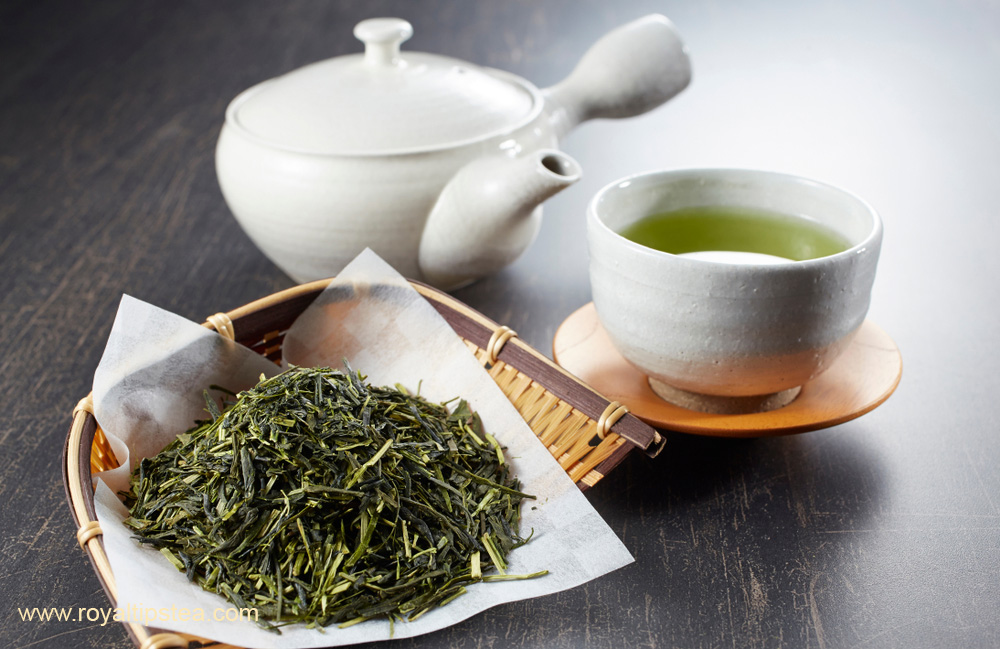
After the very limited Shincha harvest, Sencha is the first main harvest of the year and is processed by steaming, hence its name. This method of stopping oxidation by steaming the freshly picked leaves was invented in Japan in 1738. Most Sencha teas are harvested mechanically and can be processed by hand or machine; it is the most widely produced and consumed tea in Japan.
Bancha
Bancha is made from the 2nd, 3rd and 4th harvests picked in June, July, August and September, and is therefore a lower grade than Sencha. Most Bancha is harvested mechanically and can be steamed or panned.
Kabusecha (the word comes from ‘kabuseru’ meaning to cover or place on top)
Some of Japanese teas are shaded before they are picked. If the word Kabusecha appears on a packet of tea, it means it has been shaded.
There are two types of shading:
- ‘Jika-gake’ directly covers the tea bushes and cuts out approximately 50% of sunlight for between 7 and 10 days
- ‘Tana-gake’ shades the tea bushes under a framed canopy that sits several feet above the bushes; up to 90% of sunlight is cut out for 21 to 28 days before harvesting; in the past, rice straw and reeds were used to create the shade but today, modern materials which are easier to handle, are used.
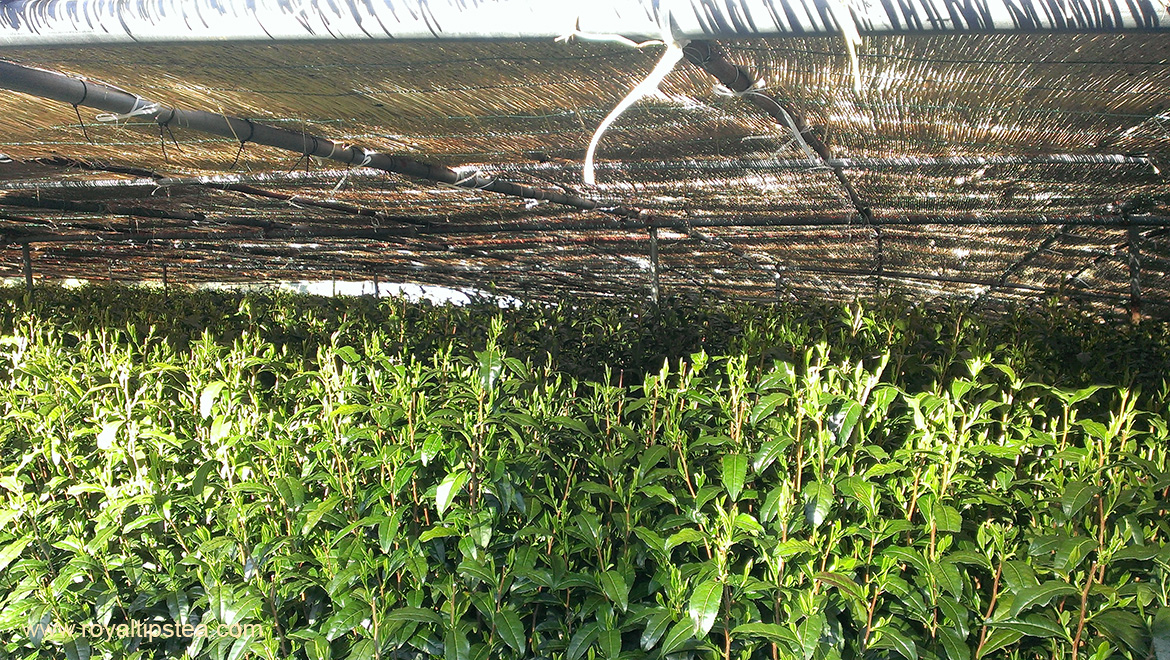
The idea of covering the bushes evolved when tea producers were trying to protect their bushes from frost; they found that if the bushes were shaded, the tea had a much sweeter, umami, more brothy taste. This is because, when tea bushes are grown in restricted sunlight, the leaves retain more of the sweet-tasting amino-acid called L-theanine, and develop fewer bitter-tasting polyphenols. The more the sunlight is cut out, and the longer the period of shading, the higher the level of L-theanine, and the sweeter and umami the taste of the tea. Shaded teas also contain more chlorophyll and caffeine.
Some Sencha teas are shaded by the ‘jika-gake’ method and are therefore a better quality, more umami and sweeter than unshaded Senchas.
Gyokuro (meaning ‘jewel dew’, ‘jade dew’ or ‘precious dew’)
Gyokuro is considered the very best of Japanese teas and is brewed with more leaf than usual to the amount of water. It is a very special tea and is drunk in small quantities from small tea bowls on special occasions. It is shaded for 21 to 28 days by the ‘tana-gake’ framed canopy method and is picked by hand in late April and early May, at the beginning of the season. It is usually processed by hand using the ‘temomi’ (meaning hand-rolled) method on a special heated table called a hoirou table.
Tencha (meaning ‘mortar’ or ‘grind’)
The name of this very special tea refers to the fact that Tencha is ground to make Matcha, the finely powdered green tea that is whisked into hot water and served at a Japanese Green Tea Ceremony. Tencha is shaded in the same way as Gyokuro and is picked, processed and dried in the early part of the season. All the stalks and fibres are removed from the dried tea so that, when it is ground to make Matcha, it is only the finest fleshy part of the leaves that are used. The grinding must be carried out very slowly in traditional stone mills and only 40 grams of matcha is made in one hour. If the grinding process is speeded up by more modern methods, there is a risk that the tea will be damaged by the build up of heat.
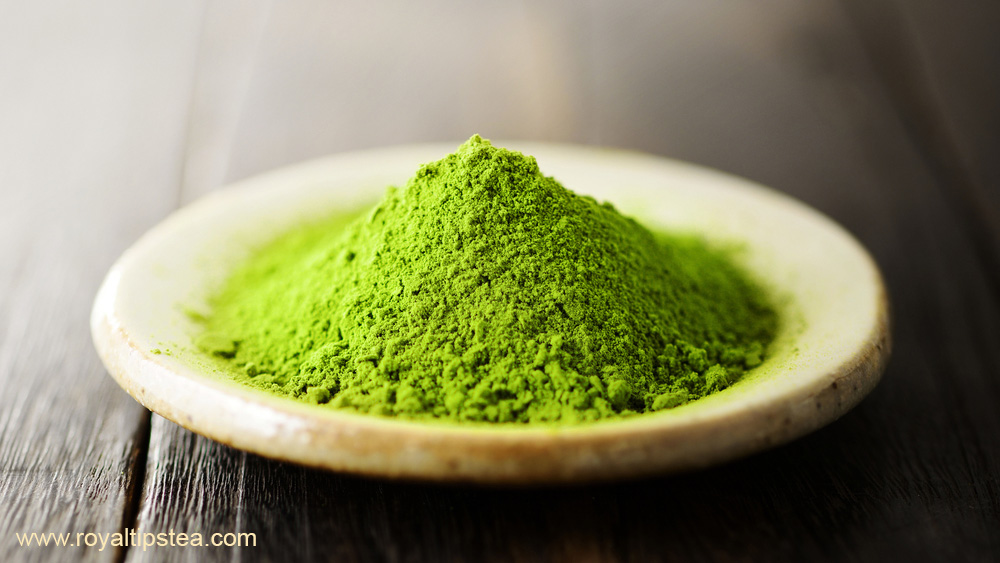
Karigane (meaning ‘cry of the wild goose’ or ‘wild goose’)
Karigane is the stems, stalks and twigs that have been separated from Gyokuro or shaded Sencha. This tea therefore has a sweet, brothy and umami character. The name comes from the fact that the small pieces of stalk that float in the tea while it is being brewed look like pieces of driftwood that provide a welcome resting place for wild geese during their migratory journey each year.
Kukicha (meaning ‘twig tea’)
Kukicha is the stems, stalks and twigs that have been separated from Sencha or Bancha leaves; it has not been shaded and is a lower grade tea.
Kamairicha (meaning ‘the tea of the pan’)
Kamairicha is a panned tea, rather than the more common steamed tea made in Japan. Japan learned how to make tea from the Chinese and so when the Chinese steamed their teas, the Japanese copied; when the Chinese started to pan their teas, Japan did the same, but then developed their own way of steaming the leaves in the 18th century and Sencha was born. Tea and knowledge about processing tea arrived into Japan from China through the south western area of Kyushu, the closest region to the Chinese coast, and it is in that region that processors have kept to their old traditional ways and still make panned green teas.
Tama Ryokucha (meaning ‘coiled green tea’; also called ‘Guricha’, meaning ‘curled tea’)
This tea can be steamed or panned and, instead of being rolled into shiny flat needles like most Japanese teas, it looks more like a hand rolled Chinese tea. Most of these teas are made in the Kyushu region
Hojicha (meaning ‘roasted tea’)
Hojicha is made from a steamed green tea (an ordinary Sencha, Bancha or Kukicha) that is roasted. This turns the leaves to a mid brown colour, gives the tea a mellow, toasty, nutty flavour and reduces the amount of caffeine in the tea.
Genmaicha (meaning ‘brown rice tea’ or toasted white rice tea’) sometimes called ‘popcorn tea’)
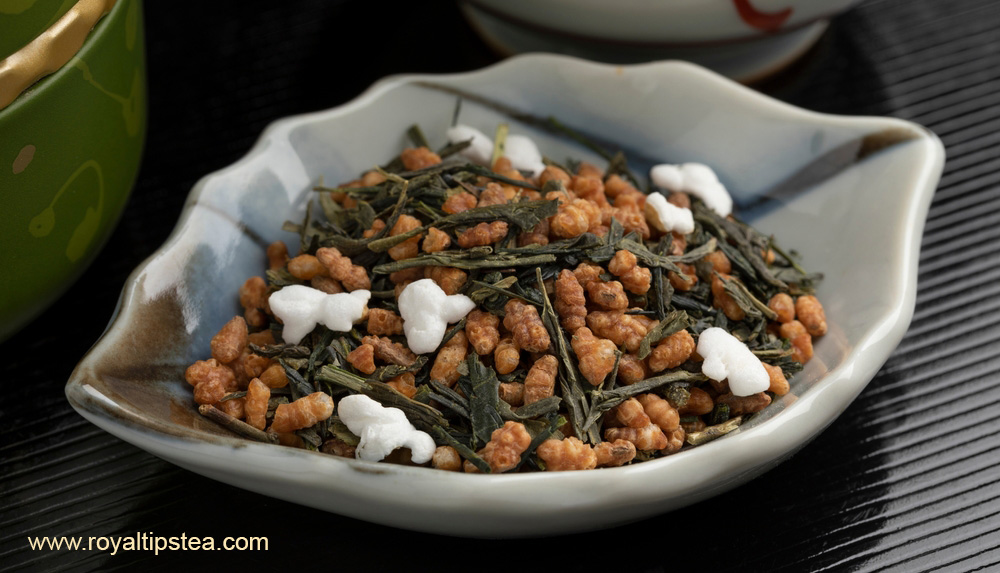
Genmaicha can be made using an ordinary Sencha, or Bancha, or Kukicha green tea to which is added roasted popped rice. ‘Genmai’can refer to brown rice or toasted white rice. One story about how it came to be made tells that in the 15th century, a servant who had stolen some rice from his master and hidden it in his sleeve, accidentally dropped some into his master’s bowl of tea. His master was very angry and is said to have immediately beheaded his servant, but then sat down to drink his tea and found that he really liked it.
Another story says that in the early 20th century, tea merchants combined their green tea with rice to make it go further during times of poverty. To make this kind of tea, the rice is soaked in water, steamed, dried, roasted and cooled. During the roasting some kernels of rice pop and so the tea is sometimes known as popcorn tea.
Matcha iri Genmaicha (also Genmaicha Matcha-Iri)
This modern mixture of Genmaicha with powdered green matcha was introduced a few years ago as a reaction to the rapidly increasing interest in matcha and its high levels of health benefits. The blend adds the pleasant nutty, toasty flavour of the Genmaicha to the slightly bitter flavour of the Matcha and makes it more palatable.
The post All about Japanese teas first appeared on Blog Royal Tips.
]]>The post Masala Chai Tea: History, Ingredients and Benefits first appeared on Blog Royal Tips.
]]>The History of Chai Tea
The most famous and popular type of spiced milky tea is the version made in India and the popularity of the drink seems to have grown during the 19th century when the British established and developed tea cultivation in Assam and Darjeeling in the north east, and in the Nilgiri Hills in the south west of the country. Although large quantities of black tea, made in those regions, was being shipped back to Britain for consumption there and elsewhere in the west, the Indians themselves did not drink much tea.
A campaign in India by the Indian Tea Association, a British owned tea promotional body, to encourage the consumption of tea within India, helped to increase sales and led to businesses being set up by a growing number of ‘chai wallahs’ or brewed tea merchants. Since the British by that time were drinking their black teas with milk and sugar, the same became popular in India, but many of the tea vendors also began to add locally grown spices such as nutmeg, cloves and cardamom.
It is possible that the use of spices developed from ancient ayurvedic medicinal recipes that used different spices for their various health benefits.
Traditional Recipe and Ingredients
Today chai is popular all over India, sold from stalls in the street and brewed at home. Modern recipes usually include strong black tea, milk, sweetener of some kind, and a mix of spices. These ingredients are boiled up together until all the flavours develop and balance with each other to create a wonderfully rich, warming sweet, spicy and invigorating, comforting drink.
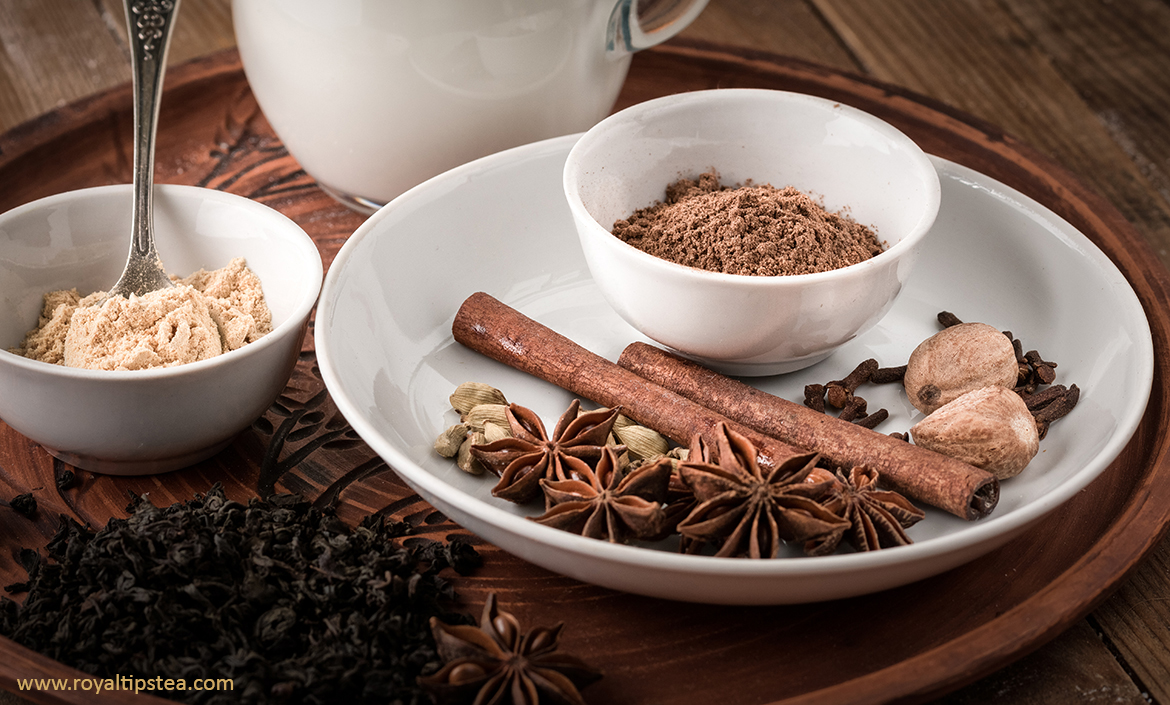
In the north of India, the black tea used is usually strong black Assam CTC, while in the south a Nilgiri CTC or broken black grade is the base tea. The tea needs to be really robust and full of flavor so that it is not overwhelmed by all the other strong tastes and aromas.
The milk used in India is traditionally water buffalo milk but in other parts of the world it is usually cow’s milk. The milk is usually mixed one part milk to two, three or four parts water. Some people use evaporated or condensed milk to give extra sweetness. Any kind of sugar (soft brown, demerara crystals, syrup, honey, palm sugar or cane sugar) can be used and in India, many people use jaggery, an unrefined sugar made from sugar cane juice or palm juice and then reduced to give a very rich sweet flavor.
In India, the spice mix, called ‘karha’, varies according to region, vendor or household and if you ask for the recipe, everyone will tell you something different. The traditional ingredients usually include grated fresh root ginger, green or black cardamom, and black pepper, but different merchants might also add cloves, nutmeg, mace, cinnamon, start anise, and fennel seeds. In the south, fresh basil leaves are sometimes used and occasionally the blend will also add chilli powder, cayenne pepper, cumin, rose petals, a little salt, or liquorice root. In Western India, the recipe rarely includes cloves and black pepper, and in Kashmir, green tea is used instead of black and the ‘karha’ spice mix uses more subtle flavours such as almonds, saffron and cardamom.
Chai wallahs and people at home in India usually make up their own mix of flavourings, whereas commercial mixtures sold in grocery stores usually restrict the number of spices to fewer traditional ingredients.
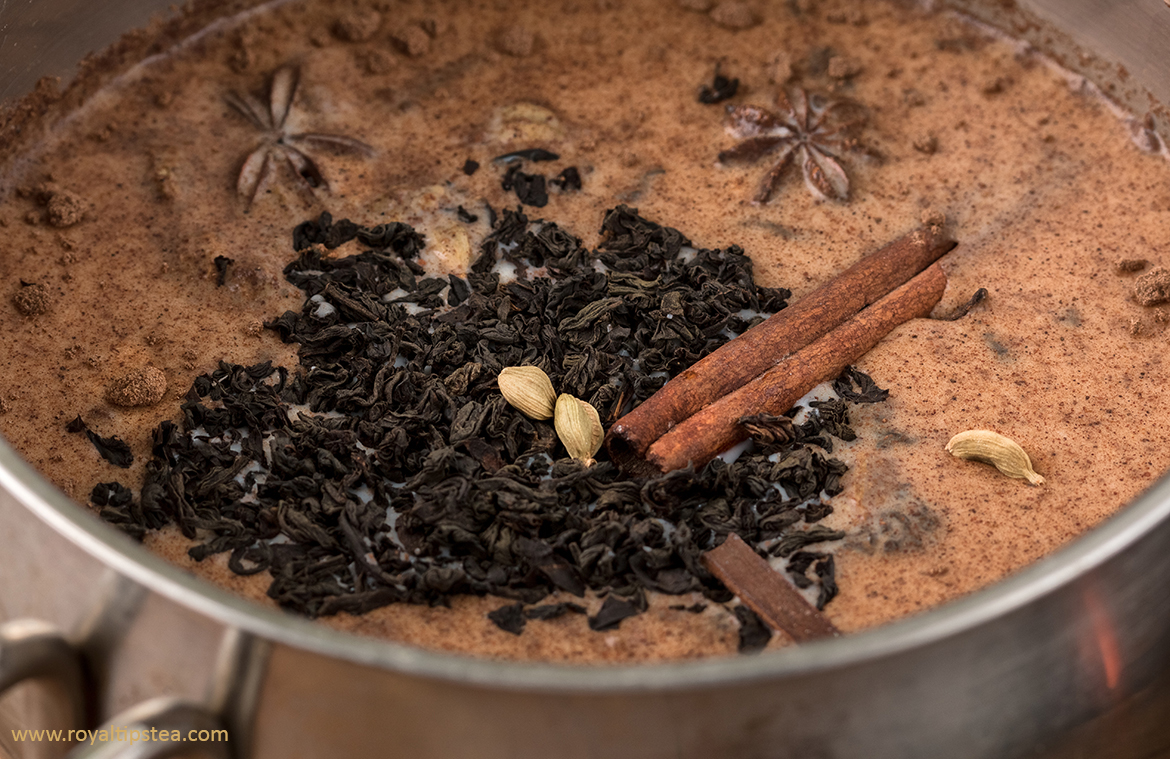
To prepare a good chai, everything is put into the pan together to allow the spices and the tea to fully infuse their flavours and strength into the brew.
At street stalls, once the liquids have been brought to the boil, the pan or kettle is set to simmer and when ready, the solids are strained off and the thick, sweet beverage is served in little handleless, unglazed terracotta clay cups called ‘kulhars‘. These are cheaply made and the intention is that, once the customer has drunk the chai, the cup is smashed on the ground, returning it to the earth in pieces of broken earthenware with the result that no plastic or paper cups are left littering the streets.
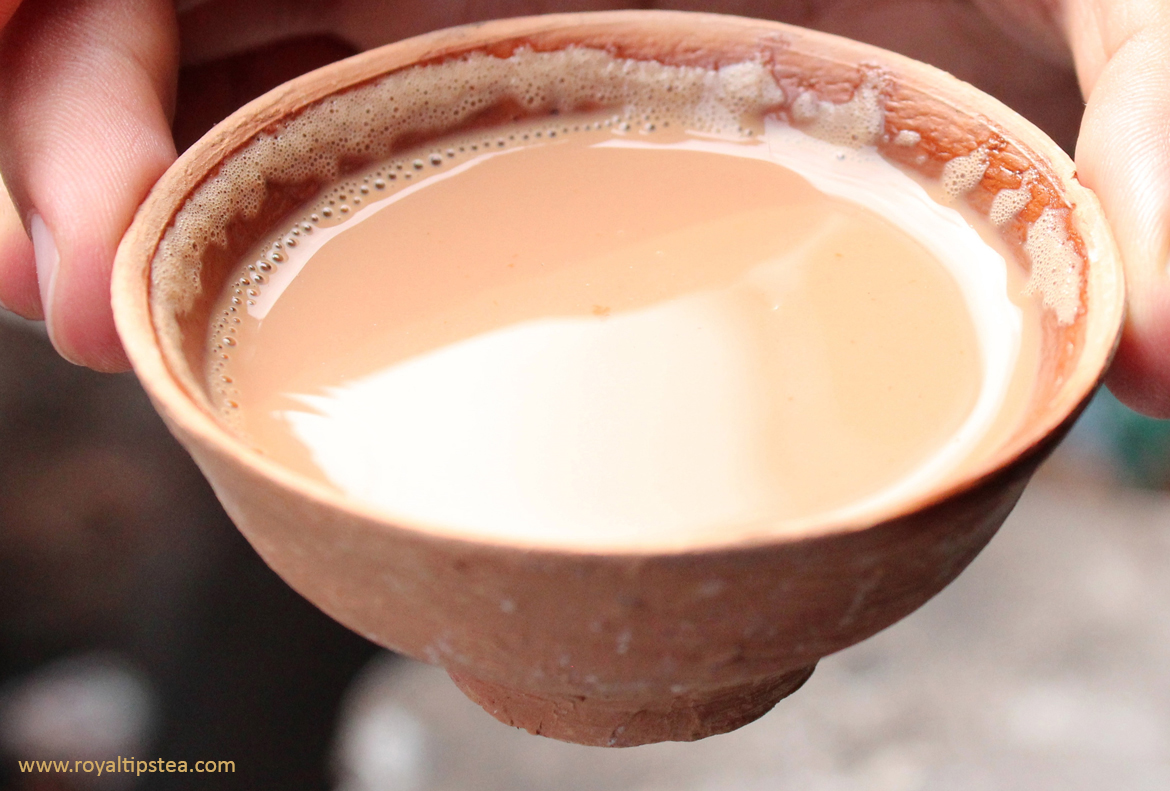
Masala chai is also popular in East Africa, Qatar, Kuwait, Saudi Arabia the United Arab Emirates, where it is known as ‘chai karak’.
Over the past 15 to 20 years, chai has become more and more popular in the West where companies offer a range of concentrated tea-based syrups that are designed to be diluted with hot water or milk; teabag blends that mix black tea, rooibos or yerba mate with a selection of spices and are designed to be brewed in hot water; ground spice mixtures that can be added to a cup of tea after it has been brewed; soluble granules for stirring into hot water rather like instant coffee granules; and unsweetened iced-tea powder for adding to a blend of spices, sugar and milk.
The beverage can be served hot or iced, and some café and restaurants even offer an additional shot of espresso coffee and call the resulting brew ‘java chai’ or ‘Dirty Chai’. Recent health trends have also led to brands offering turmeric chai and matcha chai.
Benefits of Chai Tea
As well as giving hot sweet milky tea its invigorating, warming and comforting spicy character, the individual spices in the mix are also thought to offer wide a range of health benefits.
Cloves, cinnamon and ginger are all thought to have an anti-inflammatory effect and can therefore be helpful against rheumatoid arthritis and other conditions that cause swelling of the joints. Cloves are also said to boost the immune system, have antibacterial properties, protect the liver, and help control diabetes.
Cinnamon is a source of antioxidants, also helps fight diabetes, infections and viruses, and protects the teeth.
Ginger stimulates the circulation, helps cure nausea, motion sickness and upset stomachs. It may also help indigestion, reduce blood sugar and cholesterol levels and protect against heart disease.
Cardamoms are related to ginger and may also help indigestion, calm nausea, clean the kidneys, and stimulate the appetite.
Black peppercorns stimulate the taste buds, have antibacterial properties, can help against weight loss, and are also said to improve brain function.
Fresh basil, so popular in southern Indian versions of the brew, are also said to act as an anti-inflammatory herb, to have antibacterial and anti-microbial properties, combat stress and fight depression.
The tea, of course, also delivers antioxidant polyphenols into the body and a beneficial dose of L-theanine that produces alpha waves in the brain and calms mental and physical stress.
No wonder this deliciously satisfying nourishing and uplifting drink is becoming so popular around the world.
The post Masala Chai Tea: History, Ingredients and Benefits first appeared on Blog Royal Tips.
]]>The post The Story of Earl Grey, Bergamot Flavoured Tea first appeared on Blog Royal Tips.
]]>Earl Grey Tea Legends
There are many different stories about the origin of the blend but it is doubtful that any of them are true. Some say that Earl Grey himself travelled to China where he was presented with a recipe for black tea scented with bergamot by an important Chinese official; or perhaps by a Chinese tea master.
Other versions of the legend say it was a group of British diplomats who travelled to China and were given the recipe for the Earl after one of the diplomats had rescued an important official from drowning, or perhaps it was the official’s son.
Whether these tales have any truth in them is something we shall almost certainly never know, but it is commonly believed that the tea was named after Charles Grey, 2nd Earl Grey, who served as British Prime Minister from 1830 to 1834 and is said to have been given, at some point, a blend of black China tea flavoured with bergamot, a citrus fruit that is thought to be a hybrid of sweet lime and bitter orange.

Bergamot is today cultivated in southern Calabria in Italy, in South America, Morocca, Tunisia and Turkey, and came originally from such countries as Vietnam, Myanmar, Laos, Cambodia, Malaysia, and Indonesia in South East Asia, but not from China. So it is unlikely that a Chinese tea master would have used it in a tea blend or that any recipe coming out of China would have included it.
Directors of the East India Company, a modern retail business that uses the old name of the famous British trading company from the 17th, 18th and 19th century, claim that their Earl Grey follows the original recipe. They claim that the tea was first written about in the 19th century by George Staunton a botanist who worked for the East India Company and claimed to have seen tea being scented with neroli (bitter orange blossom).
Back in Britain, neroli was not available at that time, and so the East India Company claim that bergamot was used instead to replicate the aromatic notes of the orange blossom. The Staunton Earl Grey (names after George Staunton) sold by the East India Company today, includes both neroli and bergamot in the recipe.
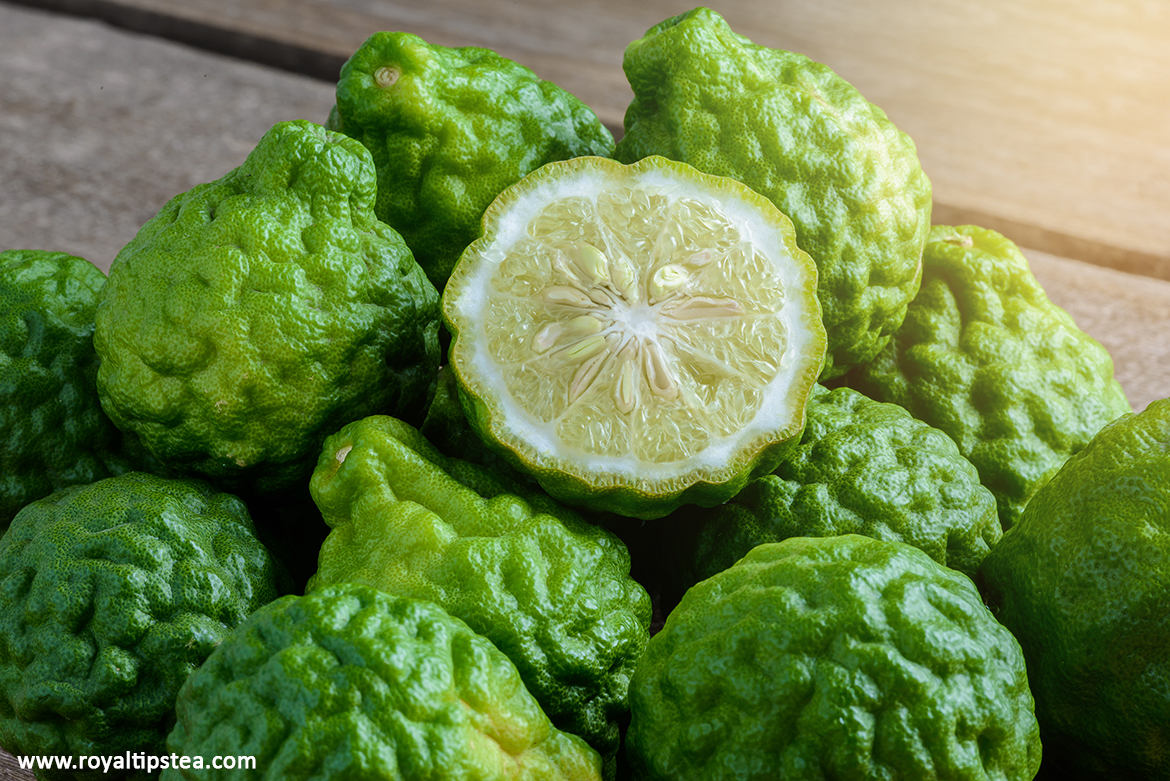
The first evidence of sales of a bergamot-scented black tea blend in Britain dates back to 1824, six years before Earl Grey became Prime Minister. In 1836, Jacksons of Piccadilly, who claim to have the original recipe, introduced it “to meet the wishes of a former Earl Grey”, so perhaps Charles wasn’t involved at all and it was his father’s name that was used.
In the 1850s, a ‘Grey’s Tea’ was advertised by Charlton & Sons of St James’s London. The Grey family, Charles Grey’s descendants, have more recently suggested that black tea was blended with citrus bergamot to suit the very hard water at Howick Hall in Northumberland, the family’s ancestral home, and the water in London, where Charles Grey obviously spent a lot of time since he was involved in national politics. The rationale behind the use of bergamot would have been based on the fact that a few drops of juice from a citrus fruit stops hard water (containing high levels of limescale) from becoming cloudy, and also prevents a scum from developing on the surface of the tea.
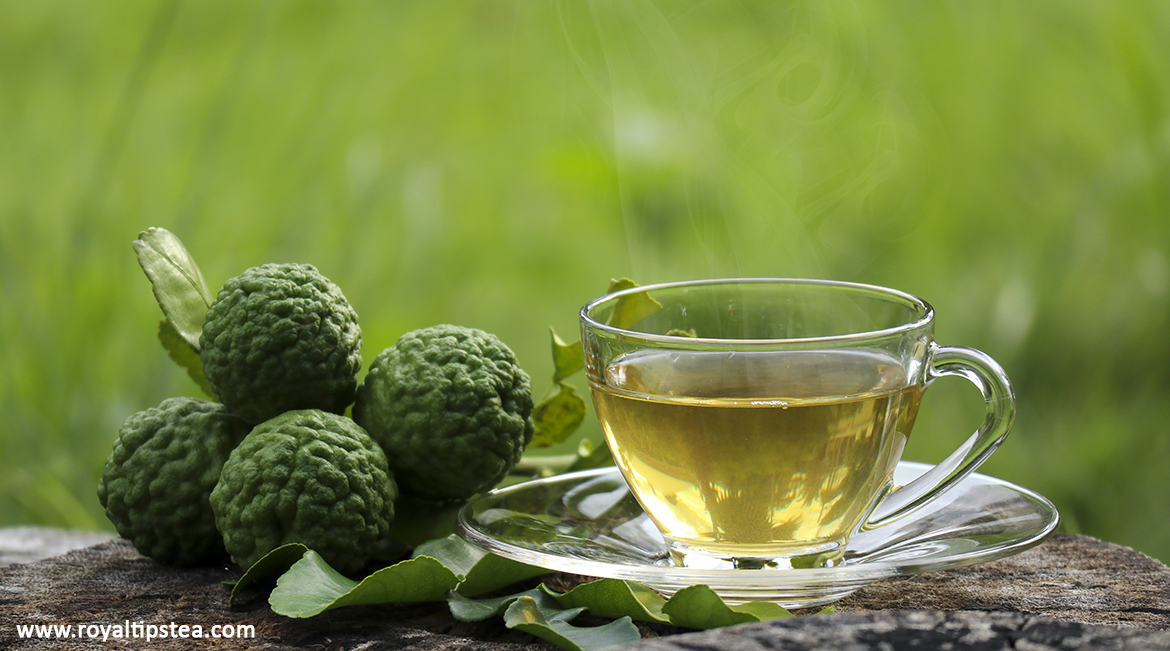
Varieties and Ingredients
Since the days of those early recipes, Earl Grey blends created by different companies today use Ceylon, South Indian or China black teas as the base, and even sometimes choose green, white or oolong teas. The flavouring ingredients always include natural or artificial bergamot oil, and sometimes also add other citrus fruits such as orange, lemon, clementine, mandarin or lime, and other visually attractive ingredients such as cornflower blossoms, sunflower petals, or pieces of dried citrus peel.
Different companies will continue to invent new recipes for this famous tea but two elements will no doubt remain constant. Bergamot will always be included in the list of ingredients and tea drinkers will continue to discuss the origins and history of the blend.
The post The Story of Earl Grey, Bergamot Flavoured Tea first appeared on Blog Royal Tips.
]]>The post A Guide to Ceylon Tea Tastes and Growing Regions first appeared on Blog Royal Tips.
]]>Often referred to as “The Pearl of the Indian Ocean”, the island of Sri Lanka (former Ceylon) has been growing tea for more than 150 years. Lying close to the equator, the country’s benign climate allows the tea plants to push out their new leaf shoots all year long.
In the southern mountains, the contours of the hillsides are covered in every direction with undulating fields of tea, punctuated by tumbling waterfalls and plunging rivers, rugged outcrops of rock, elegant palm trees, bamboo stands and dense thickets of forest pines.
From the steamy south-western coastal plains, the tea gardens scramble up to altitudes of 1800 metres (6000 feet), ), where temperatures are cooler and misty clouds swirl gently around the highest peaks, protecting the tea from the glaring sunlight and bringing essential moisture to the plants.
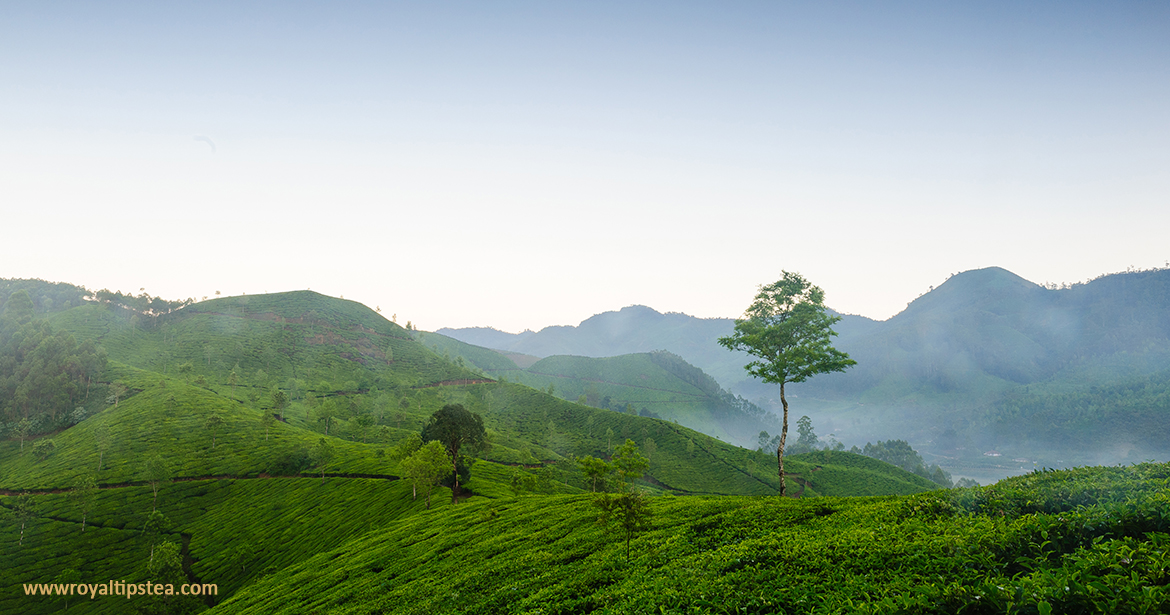
Ceylon teas are categorized by three different altitudes:
• Low-grown teas (from sea level up to 2000 feet)
• Medium-grown teas (between 2000 and 4000 feet)
• High-grown teas (above 4000 feet)There are currently seven tea growing regions in Sri Lanka:
Ruhuna, Sabaragamuwa, Kandy, Dimbula, Uva, Uda Pussellawa y Nuwara Eliya.
Each region produces teas with unique tastes and distinctive aromas.
Low-grown teas – Ruhuna and Sabaragamuwa
The climate in the low-growing regions of Ruhuna and Sabaragamuwa is hot and humid with plentiful rainfall throughout the year, and the bushes confidently produce a regular crop of new leaf buds. The majority of the teas grown here on the lower slopes are processed as Orange Pekoes (OP) and Flowery Orange Pekoes (FOP).
Their beautiful leaves are wiry, neatly-twisted, jet-black, and often mingled with silver or golden buds.
They brew to give rich red liquors that are full-bodied, powerful, juicy and strong, with hints of honey and chocolate.
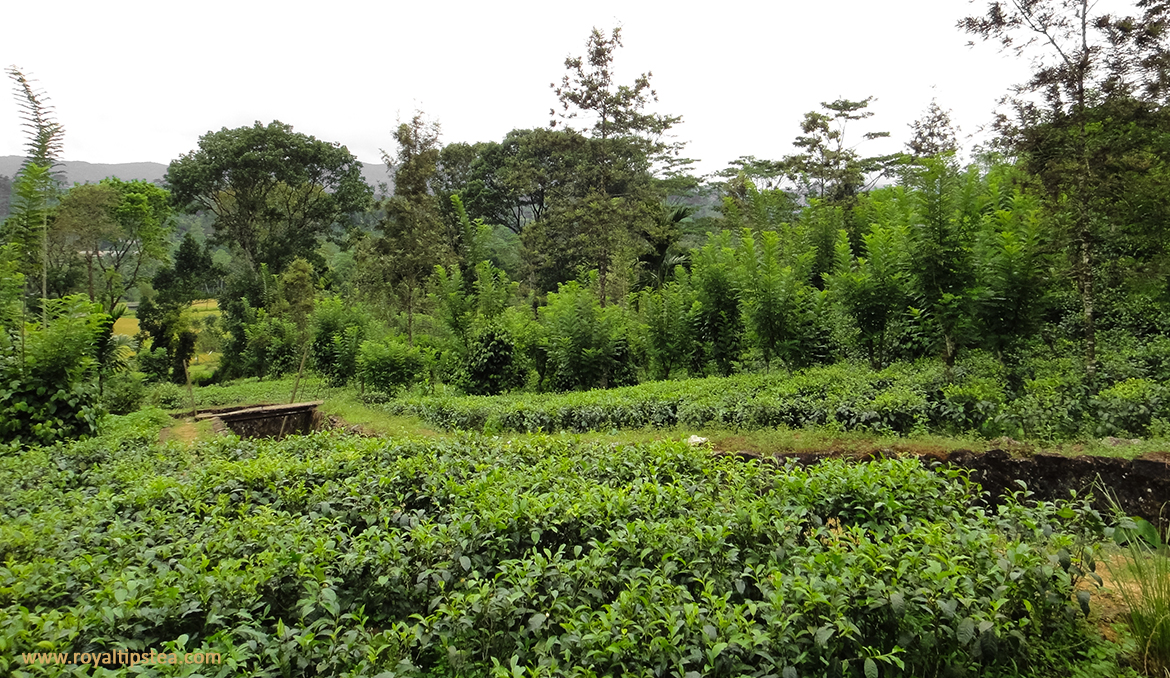
Medium-grown teas – Kandy
The ancient town of Kandy, once the island’s capital before Colombo took over that role, nestles in a valley on the western side of the Central Highlands. A beautiful and privileged place blessed with a generous nature.
A world heritage site declared by UNESCO in 1988, it was in this region that the first Ceylon tea gardens were established.
A Scot named James Taylor was working at Loolecondera Coffee Plantation in the 1850s when his employers encouraged him to diversify and try growing tea as well.
When his first tea plants thrived, he planted out a further 20 acres and, with little knowledge and no processing machinery, he started making black tea by hand on the verandah of his house and gradually developed his own machinery.
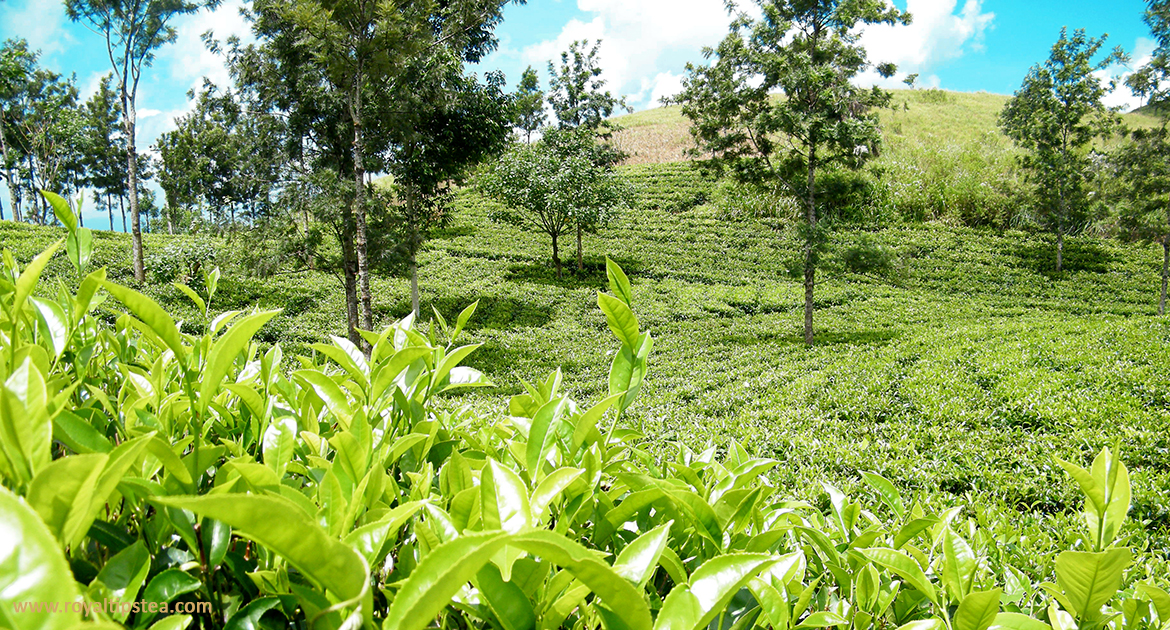
In 1873, he sent 23 lbs of black tea to London, where it was sold to great acclaim in the London tea auctions.
When Ceylon’s coffee crop was devastated by a virus in the early 1870s the coffee planters around Kandy were encouraged by Taylor’s success and started growing tea instead.
By 1890, Ceylon had become a very important tea producing country.
Large-leafed Kandy teas are strong and full-bodied, sometimes malty, while the smaller grades are more delicate and subtle.
High-grown teas – Dimbula, Uva, Uda Pussellawa and Nuwara Eliya
Sri Lanka has four high-growing regions (Dimbula, Uva, Uda Pussellawa and Nuwara Eliya), and the tea plants grow amongst mountain peaks that soar upwards to an altitude of more than 2500 metres (8281 feet).
Dimbula
Dimbula’s tea gardens sweep across the western slopes of the mountain range and clamber upwards though steep craggy hills and mountain passes towards the high Nuwara Eliya plateau.
Heavy monsoon rain gushes into the area from June to September and during those misty, warm months, the teas are full of flavour and aroma.
When the weather is cooler and dryer at other times of the year, the peak quality teas are lively, bright and fresh, with hints of oak, cypress, spice, citrus fruits, roses and jasmine. The higher the estate, the fresher and brighter the teas.
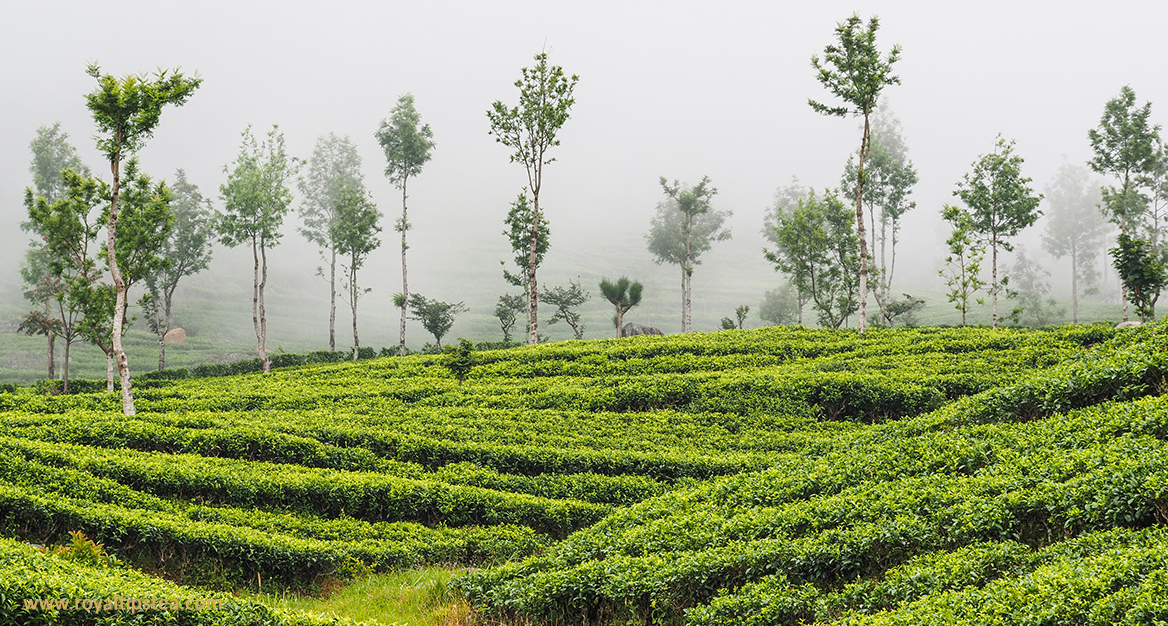
Uva and Uda Pussellawa
On the eastern side of the mountain range lie Uva and Uda Pussellawa, where the weather alternates between a period of heavy rain and high temperatures from October to June and a cooler season from July to September, when a powerful drying wind blows through the region.
The dessicating wind upsets the plants’ normal photosynthesis, and the contrast between cool nights and warm days causes a chemical change in the tea bushes.
The two factors together give the tea liquors a unique ‘wintergreen’ character.
During this period, the manufacturers change their style of processing (rolling the leaves more heavily and making smaller grades) to capture this prized medicinal taste and aroma.
Nuwara Eliya
The highest of all Sri Lanka’s teas grow in Nuwara Eliya, established as an important tea growing region in the 1870s.
The high altitude and the cool, sometimes frosty, air produce fine teas that are delicate, aromatic, subtle and complex.
The new leaf buds develop slowly and distill some of the aromas carried by the mountain breezes (eucalyptus, cypress and wild mint).
The golden sparkling liquors suggest ripe plums, spices and citrus fruits.
La elegancia y la delicadeza de té de Nuwara Eliya lo convierten en el favorito para beber todos los días.
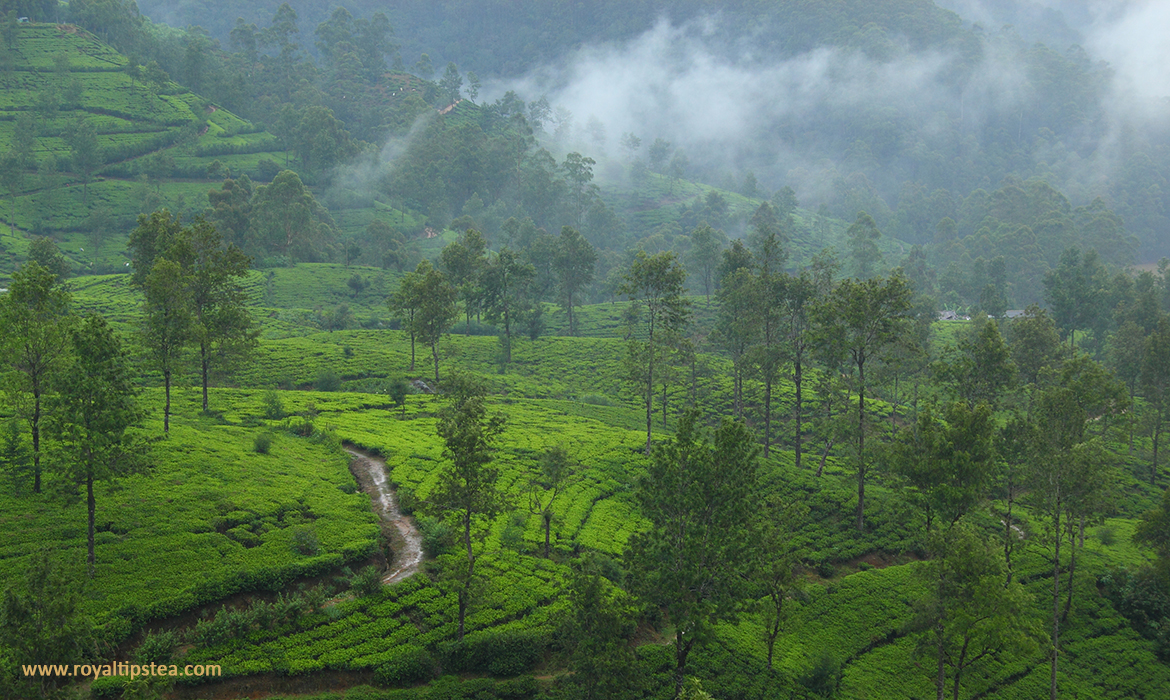
The post A Guide to Ceylon Tea Tastes and Growing Regions first appeared on Blog Royal Tips.
]]>The post Da Hong Pao, The Most Expensive Tea in the World first appeared on Blog Royal Tips.
]]>In 2002, 20 grams of Da Hong Pao (Big Red Robe) tea was sold for 180,000 yuan – equivalent to almost US $28,000. That works out at $1400 for 1 gram of the loose leaves and more than US$10,000 to brew a pot, and it makes this beautiful oolong the most expensive in the world.
Oolong translates as ‘black dragon’ and the large, twisted, brownish-black dry leaves often resemble dragons or serpents.
What is Da Hong Pao and where does it come from?
This world famous tea is produced in the Wuyi Mountains in the north west of Fujian province, an area that has a very long tea history and which in 1992, were designated a UNESCO World Heritage site. The soil in this volcanic mountain range is very rocky and the plants have to wind their roots around the rocks to find the nutrients and water that they need to thrive.
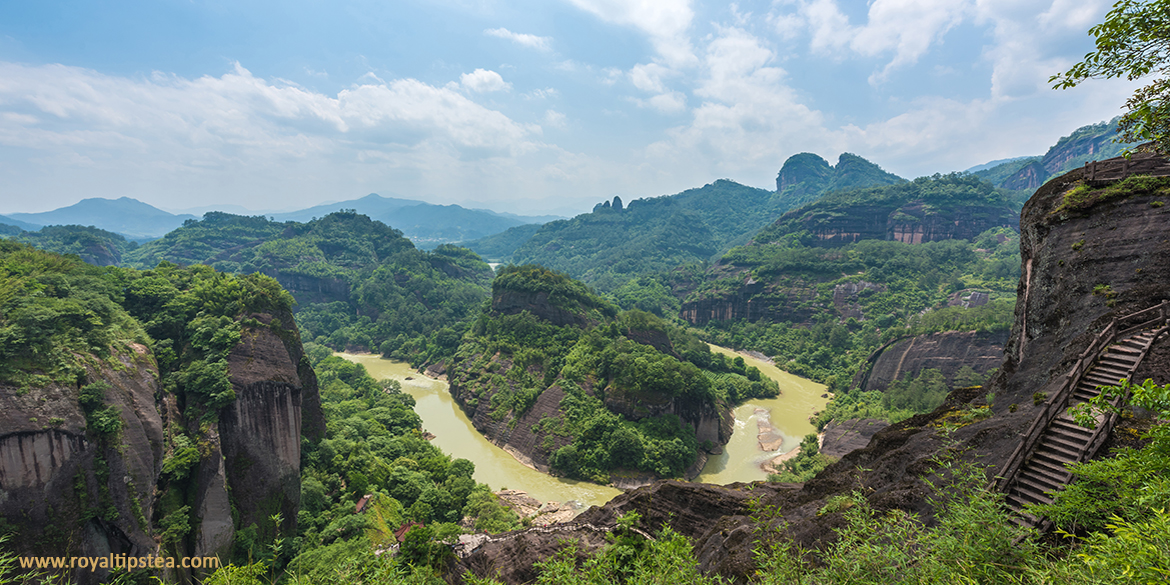
The teas made from their leaves are known as ‘rock oolongs’ or ‘yan cha’ and often have a mineral, almost flinty, wet stone character that is described as ‘petrichor’, a word devised in 1964 to mean the smell of wet earth or stone after rain has fallen (from Greek ‘petra’ meaning stone’ and ‘ichor’, meaning the fluid that flows through the veins of the gods in Greek mythology.
The bushes from which that very expensive Da Hong Pao was made sit high up on a rocky ledge in a narrow gorge surrounded by tall pillars of rock, and no-one, except a small number of designated tea masters, is allowed to approach anywhere near.
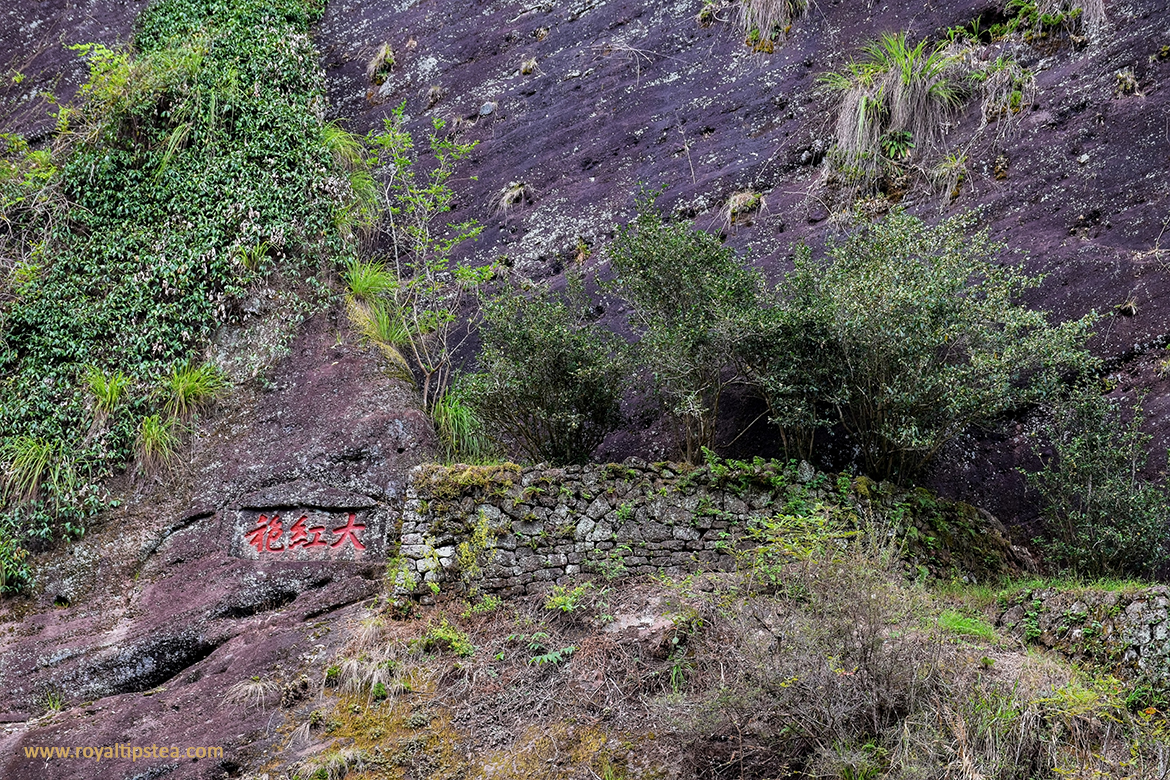
The group of four bushes (some people count 6 to include two bushes that sit slightly below the other four) have been growing here since the time of the Ming Dynasty (1368 to 1644 AD).
They became famous when the mother of a Ming Emperor was cured of an enduring illness by tea made from their leaves and the emperor sent his ‘Big Red Robe’ to cover and protect the precious bushes. Each year, only around 400g of oolong tea is made from those original bushes and it is either presented by the Chinese government to very important visiting dignitaries or it is sold at very high prices.
But not all Da Hong Pao teas cost so much and that’s because, over the centuries, cuttings have been taken from the original mother bushes and cultivated in the surrounding area. But the taste and aroma of tea made from those younger bushes vary according to the specific location where they grow. The soil, weather patterns, temperatures, amount of sun and rain, etc. can affect the way in which the bushes grow and the eventual flavour of the tea in the cup.
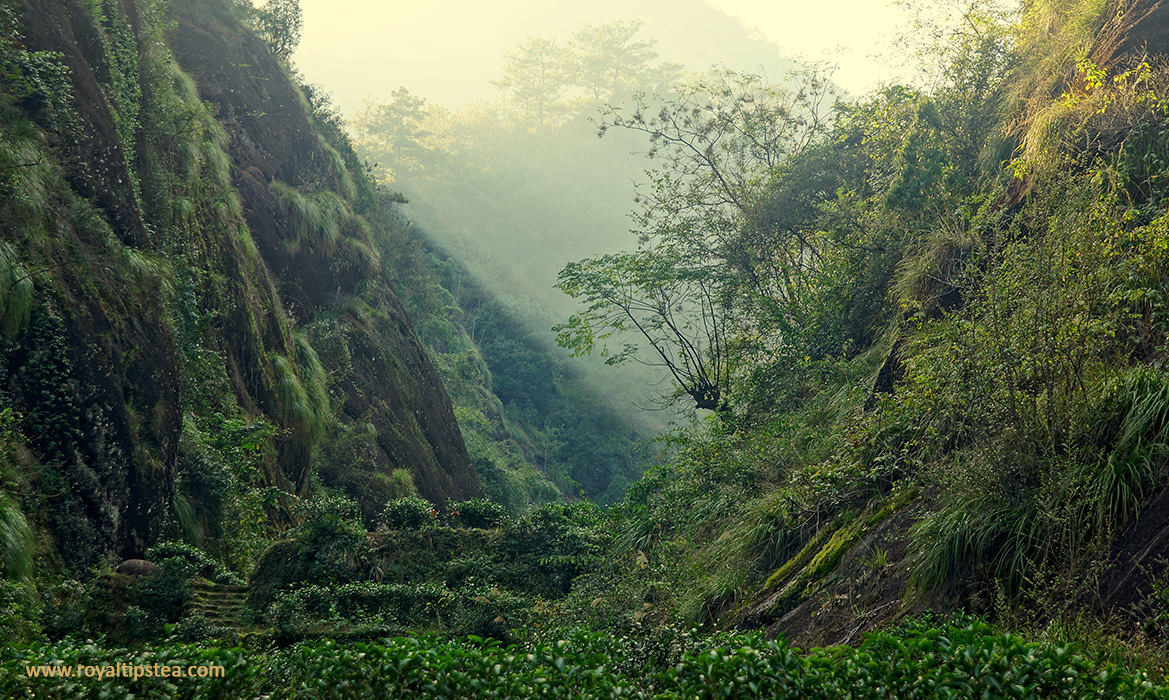
Production of Da Hong Pao oolong tea
This chinese tea is made by the usual dark oolong method.
- Shoots of 3 or 4 open leaves (no buds) are gathered in the late spring and autumn and withered in shady sunlight for about two hours.
- Then they are taken indoors, spread on bamboo baskets, and from time to time shaken, and tumbled inside a bamboo drum to gently bruise the leaves in order to provoke around 30%-40% oxidation.
- When the desired level of oxidation has been achieved, the leaves are panned to stop any further changes in the leaves, lightly rolled to develop the flavour, and then dried.
- When the leaf comes out of the drying process, the colour of the shoots is a mixture of green and brown and the leaves are still attached to the stems. All the stems and stalks are then removed by hand (the reason why only single twisted leaves are visible in the dry leaf of Da Hong Pao).
- Finally, the tea is roasted over charcoal to further dry the leaves and to develop the wonderful characteristic layers of sweet fruity flavours in the top notes and dark roasted hints of dark chocolate, molasses, dates, cocoa nibs and dried fruits.
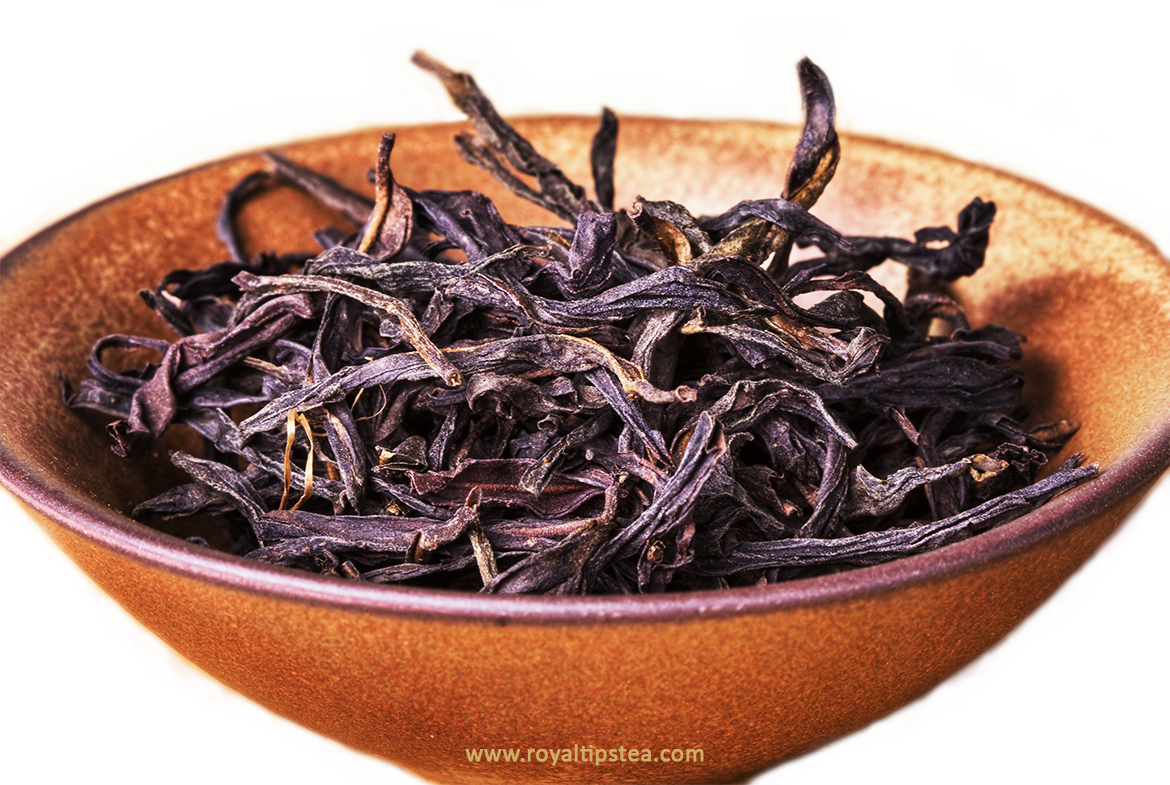
The post Da Hong Pao, The Most Expensive Tea in the World first appeared on Blog Royal Tips.
]]>The post A Guide to Jasmine Tea – Types, Production and Benefits first appeared on Blog Royal Tips.
]]>Jasmine flowers, with their pretty white petals and wonderful aroma, are popular throughout the world. Their beautiful appearance and calming fragrance mean that they have come to be associated with love and purity. As such, they are often used in religious ceremonies; to add a touch of elegance to bridal bouquets; and in floral arrangements for Mother’s Day. Jasmine flowers are particularly important in Eastern countries, and are amongst the national flowers of the Philippines, Pakistan, and Indonesia.
It is therefore not surprising that this aromatic plant has many practical applications too: it is grown ornamentally in gardens and homes, used extensively in the cosmetics industry to produce exquisite perfumes and bath oils, employed in herbal medicines and, of course, has long been popular as a light and calming flavouring for tea. In the following post, we look into the history of jasmine teas, from their origins to their production processes and health benefits. Read on to discover all you need to know about this wonderful scented tea and why it’s worth taking the time to relax with a cup of jasmine tea.
History
The jasmine plant, a member of the Oleacae family and native to South Asia, is thought to have been introduced to China around the 2nd century BC. Two jasmine species can be used to produce jasmine tea: Common Jasmine, and Sampaguita. Common jasmine is native to the Middle East, while Sampaguita is native to the eastern Himalayas, though both species now grow in many other countries. Common jasmine is the national flower of Pakistan, and Sampaguita the national flower of the Philippines and amongst the national flowers of Indonesia, where it is a symbol of purity and sacredness.
Jasmine has been used to scent tea since the 5th Century AD, but this process really started to become popular during the Ming Dynasty. In this era, which lasted from 1368-1644, the popularity of floral objects and patterns flourished – relics and art from the time commonly incorporate floral motifs – so, naturally, floral-scented teas also began to be consumed more. Jasmine green tea then became even more widespread in the following Qing Dynasty, when it became popular in western markets and its production and exportation rapidly increased. Nowadays, jasmine tea is traditionally produced in Fujian province in China, amongst the vast fields of jasmine plants grown on the mountain sides, although it is also produced in other provinces such as Hunan, Guangdong and Zhejiang.

Types of Tea used for Scenting
Jasmine tea is produced by scenting dry tea leaves with the intense yet delicate aroma of fresh jasmine blossoms. While lower quality teas are produced using natural or artificial essential oils, the highest quality jasmine teas are made by mixing tea leaves with the jasmine flowers, so that they naturally absorb their rich and pleasant fragrance. Tea scented in this way provides a delicate and refreshing taste, without being overly sweet. Different types of tea can be used in this process, as detailed below.
The most common and popular base is green tea, since it combines perfectly with the jasmine scent to produce a subtly sweet flavour and beautiful fragrance.
To obtain a more complex and distinct floral flavour, Oolong tea can be used, although it is less commonly found in western markets. The oxidation levels of these teas can vary considerably, without reaching the levels of black tea, so this type of tea sits between green and black tea in terms of strength.
For those who prefer a very strong taste, black tea can be used as the base: since it is made by oxidising tea leaves to their maximum, its flavour is far stronger. Enriched with the jasmine aroma, black tea can surprise us with its lightness and lack of astringency.
For those who enjoy teas with more subtle flavours, like white Silver Needle tea, jasmine aromas can be their ideal ally. The delicious and fragrant infusion of high quality, white tea harmonises divinely with the delicate aroma of jasmine flowers, making it into an incredible sensory experience for any tea lover.
Most Popular Jasmine Teas
Jasmine Dragon Perl Tea
Jasmine Dragon Pearls are popular for their freshness and charming appearance. The green tea leaves are meticulously rolled into tight little balls, to give them a beautiful neat appearance. Those with plenty of downy white tips and smaller size are the young tender flushes picked in early spring that represent the highest grade jasmine tea.
The natural jasmine scent, transferred from the jasmine flowers to the tea leaves during the production process, pairs well with the sweet flavour of green tea, adding an incredibly delicate, floral dimension to the liquor. The way the pearls unfurl in the water also produces a spectacular, hypnotic treat for the eyes when it comes to brewing the tea.
Loose Leaf Jasmine Green Tea
Just as with Jasmine Pearls, high quality jasmine loose leaf teas are made from spring-picked tea leaves which are then scented with jasmine flowers in the summer. In this case single leaves are used for scenting instead of leaf shoots.
The young tea leaves are packed with antioxidants, so they provide a lot of advantages for those who wish to benefit from the health properties of green tea, with the pleasant taste of jasmine also being gentle on the stomach.
Jasmine Silver Needles (Moli Bai Hao Yin Zhen)
Jasmine Silver Needles are the most popular scented white tea. This superb, elegant tea is made by scenting the hand-picked Silver Needle tea buds with freshly picked jasmine blossoms. The delightful, subtle fragrance of the finest white tea combines perfectly with the delicate aroma of jasmine blossoms, making it an incredible sensory experience for any tea lover.
However, it shouldn´t be forgotten that white teas can contain high levels of theine. The fresher and younger the buds, the higher the concentration of theine there will be in the dry leaves, with Jasmine Silver Needles having the highest level of all white teas since they are made using only buds from the Camellia sinensis plant.
If you are a fan of jasmine, it’s worth trying different types of jasmine tea to discover which best suits your palate: we are sure you’ll find something you love!
The Production of Jasmine Teas
To begin, tea leaves are picked in spring, when the buds are still small and any open leaves are tiny. Just the new shoots, each comprising a bud and two leaves, are used. These fresh leaves are taken to the factory, where they are toasted in order to prevent oxidation, gently rolled into small pearls, each pearl wrapped in tissue paper to hold the shape, and dried. Although they are now ready to be used as tea, they must be stored for a number of months until the ideal moment for the jasmine to be added. Jasmine flowers are harvested in the summer and so the dried tea is stored in a cool, dry place until this time.
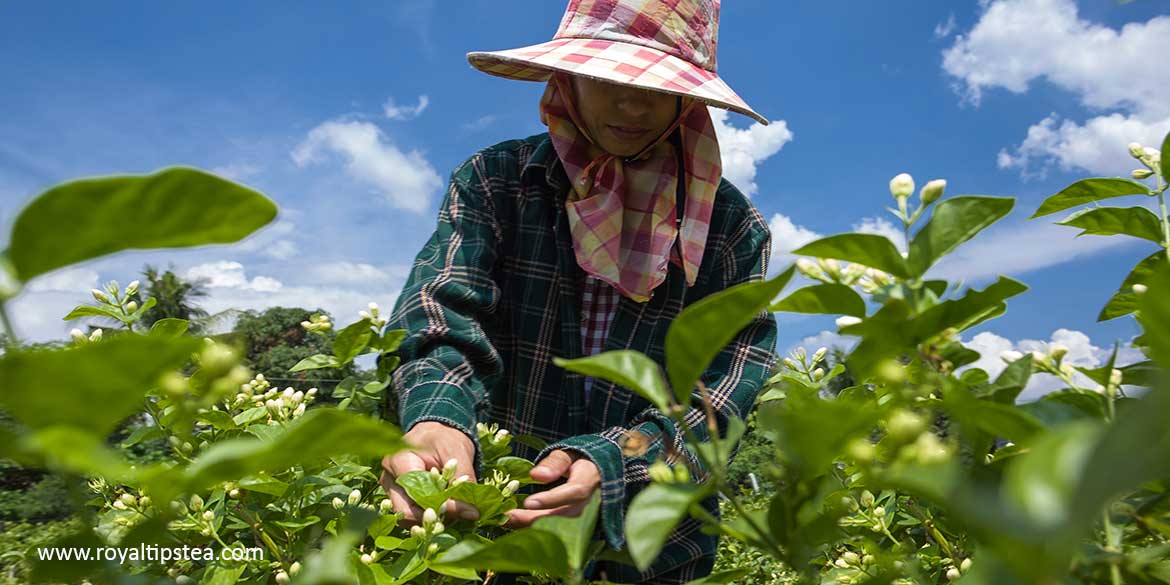
When the jasmine flowers have grown to the ideal point during the summer, they are harvested. They must be picked at the perfect moment: when they are closed during the daytime, and open up at night. If they are picked too early, the buds will not open enough for them to be used to scent the tea. If they are picked too late, when they have already flowered, they will have lost the main aromatic components. When the jasmine plants have reached this opportune stage, they can be used to scent the tea. Branches of jasmine are gathered during the day and brought into the factory and, when they open in the evening, the flowers are removed from the branches.
Then, beginning with a thin layer of jasmine flowers, the jasmine and tea leaves are placed in alternate layers and left to sit for a number of hours while their temperature rises. Once the temperature of these piles has risen to around 45°C, the mixture of tea and flowers is separated into smaller piles in order to allow the tea to cool down. Once they have almost reached room temperature, they are stacked and left again to allow the tea to absorb the fragrance of the blossoms. This process is repeated until the flowers have transferred their beautiful scent to the tea leaves.
Eventually, the blossoms transform into a light yellow colour, indicating they have completely transferred their scent. The mix of tea and flowers are placed into a machine to be sorted, separating the flowers from the tea leaves. The tea leaves are heated at a high temperature, so as to dry them out quickly and to conserve the scent. They are stored until the following night, when the scenting process takes place again with fresh jasmine flowers. This process can be repeated several times until the desired tea quality is reached – for top grade tea, it may even be repeated over eight or nine nights.
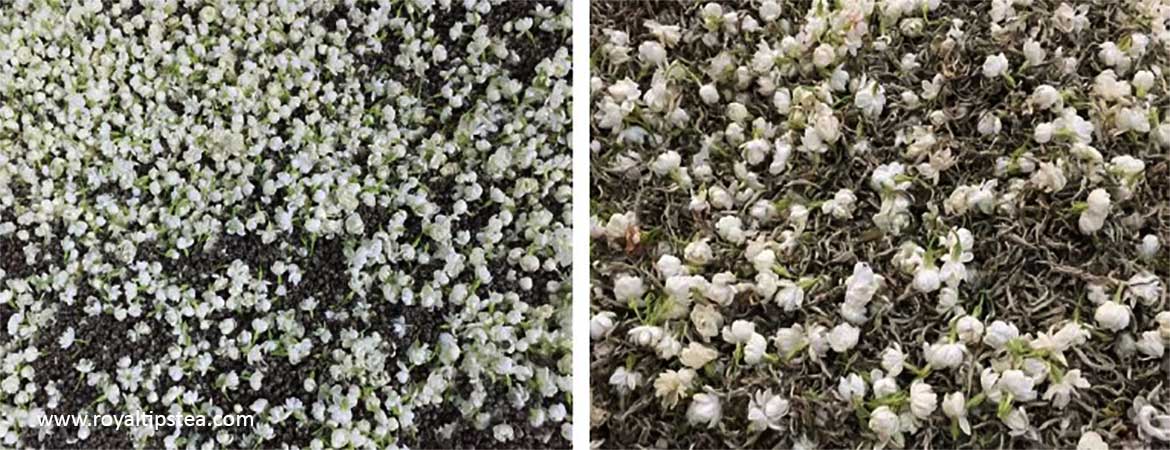
Finally, the tea is dried out again to remove any moisture it has absorbed from the fresh jasmine flowers. Some producers add dried jasmine flowers for a touch of extra decoration before packing the tea for sale.
Health Benefits
Jasmine green tea not only offers a beautiful flavour and scent, but delivers many health benefits too thanks to its high content of antioxidants, including polyphenols and caffeine (theine).
So, how do antioxidants help to maintain our health?
– Firstly, they protect the body from damage from free radicals and environmental toxins, helping to prevent age-related diseases.
– Antioxidants also help to reduce blood pressure and the risk of heart disease, and slow down signs of aging.
– They are naturally anti-inflammatory, which means they’re particularly beneficial for anyone suffering from arthritis: swelling of the joints and arthritic pain may be reduced.
– They boost your metabolism, improving the breakdown of fats. The naturally sweet flavour of jasmine tea also means there is no need to add sugar or sweeteners, further helping you to follow a healthy diet.
– They may also reduce the symptoms of IBD, particularly bloating, since they aid digestion.
– Polyphenols also fight against carcinogens, helping to prevent the development of cancer. They can also prevent the development of, and speed up recovery from, colds and flu, given their antiviral and antibacterial properties.
Finally, studies have shown that jasmine’s beautiful smell in fact acts as a mild sedative, reducing your heart rate. So savouring a cup of jasmine green tea will help you to relax and de-stress, and even help to boost your mood, as well as helping you get to sleep more easily.
The post A Guide to Jasmine Tea – Types, Production and Benefits first appeared on Blog Royal Tips.
]]>The post Tea terroir, how does it determine the flavour of tea? first appeared on Blog Royal Tips.
]]>What is a tea terroir?
The word “terroir” is used in the world of tea in exactly the same way it is used for wine. It is a French word that expresses the understanding that the flavour and character of an individual tea is influenced by much more than the genetic make-up of the plant or the processing methods employed to manufacture the tea.
It refers to everything that nature brings to each tea and includes the tea’s exact location, the altitude where it grows, the climate and weather patterns, the topography of the area (whether the land is flat or steeply sloping, etc.), the soil, the minerals in the soil and the drainage of the soil, and the local eco-system. All these factors add to the unique character of each individual tea.
Geographic location
The exact location of a tea plant affects the way in which the plant grows. If it grows on or near the equator, it will grow all year round with only slight variations in the weather. If it grows north or south of the equator, the plant will grow according to the seasons.
¿How does the location affect the flavour profile of the tea?
– In the chilly temperatures of the winter months, it will not grow at all and will only wake up and start pushing out new leaf shoots in the spring when the sun begins to bring some warmth back to the soil, and the first rains fall.
– In colder, dryer periods the plant grows very slowly and so has time, in quite stressful conditions, to create wonderful subtle flavours in the leaf.
– When the weather is warmer and wetter in the late spring and summer, the plant grows more quickly and produces stronger but plainer flavours.
– As temperatures drop and rainfall decreases in the autumn, the plant growth slows down again and so teas have a more interesting flavour profile.
In every location where tea grows, these patterns are different and so the plant growth and the flavour and aroma of the tea vary accordingly.
Altitude
Altitude is an extremely important element in tea character. When teas grow at the top of mountains at high altitudes, the weather is cooler and this causes slower growth. And mountain peaks are often surrounded by swirling misty clouds, which protects the tea from scorching sun but also cut out a certain percentage of light.
This means that the tea leaves contain more of the sweet amino acid called L-theanine which gives the tea a much sweeter, smoother, umami character. In sunlight, the sweet amino acids convert to bitter polyphenols and in reduced light, fewer amino acids are converted, so the tea tastes sweet.
Shaded teas such as Japanese Gyokuro and Kabesucha teas, or China’s Mist and Cloud teas such as Lushan Yun Wu, are soft and sweet, velvety and umami. At lower altitudes, teas such as Assam and Low-Grown Ceylon grow much more quickly and robustly and their flavours are stronger.
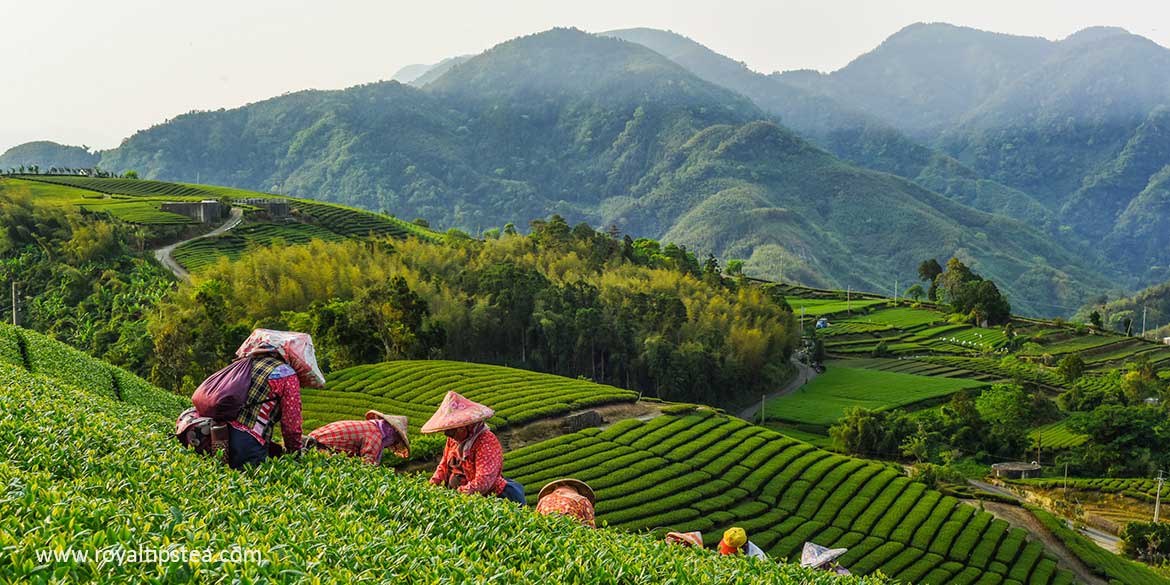
Climate
Climate and weather patterns affect the plant for the same reasons. When the weather is hot and wet, the plant grows faster; when the temperatures are cooler and /or dryer, the growth of the tea slows down. So mist or cloud, dry weather and cool temperatures develop lighter, more delicate, sweeter teas; clear skies, heavy rain and high temperatures make teas grow faster and so develop stronger, less subtle flavours.
Wind and frost also contribute to the development of character in particular tea. In Uva in Sri Lanka, the peak season teas from the high mountain district, picked during July and August each year, have a powerful mouth-filling mentholated flavour profile due to the drying Cachan wind that blows fiercely through the region for a period of about eight weeks. The plants react as if to drought conditions and the consequent chemical change that takes place in the leaves to cope with lost moisture gives the teas their unique wintergreen character. In the high Nilgiri Hills of Southern India, the tea gardens suffer frost attacks in January and February each year and the extreme cold stresses the plants and gives the teas a delicate fruity character that is quite different from the character of Nilgiri teas grown at other times of the year.
Soil and relief
The lie of the land (the topography) affects how well the soil drains after heavy rainfalls and if tea plants are left standing in water, they will quickly die. They need plenty of water around their roots but that water must drain away quickly. Sloping land is therefore much better for growing tea, and anywhere that is very flat and has soil that traps water will find it very difficult to grow tea successfully.
The minerals in the soil also add to the aroma and taste of a tea. For example, in the Wuyi Mountains of Fujian in eastern China, the rocky soil gives the teas a very particular mineral, wet stone or ‘petrichor’ character, called in Chinese ‘Yanyun’, or ‘rock rhyme’. A great example of this is a Da Hong Pao (Big Red Robe) rock oolong tea.
Volcanic soil is particularly good for tea growing as it contains so many minerals (including calcium which allows the plant to produce strong roots), and the rich mix adds to the flavour in the leaves.
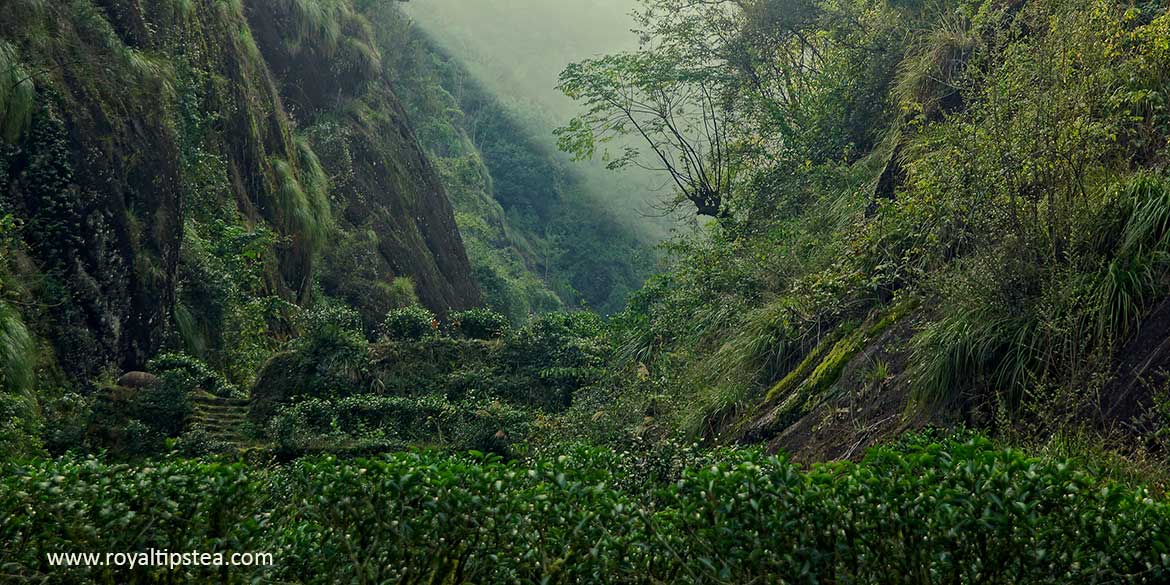
The post Tea terroir, how does it determine the flavour of tea? first appeared on Blog Royal Tips.
]]>The post The flavours of tea first appeared on Blog Royal Tips.
]]>Tea production techniques
Before ending up in our cup, tea undergoes a series of steps or processes that transform the fresh tea leaves into the end product ready to be consumed. Throughout thousands of years of its long history, these processes have been modified and refined to gradually introduce new varieties of tea as they are known today. The variations of these processes allow us to create different types of tea from the same raw material (the harvested tea leaves).
For example, to make white tea, tea leaves are simply picked and dried in the sun and indoors, while for the production of green tea, heat is applied at high temperature to stop oxidation in the leaves as quickly as possible.
The different production techniques and the order in which they are carried out will determine both the type of tea that we want to obtain and its sensorial profile, which can be light and delicate, vibrant and aromatic, intense and robust. In addition, there are all kinds of notes and nuances that contribute to the sophisticated flavour of each tea variety: sweet, fruity, floral, dairy, vegetable, mineral, earthy, etc.
The season and the type of harvest also influence the sensory profile of tea. The shoots of young tender tea leaves with plenty of buds picked in early spring will yield aromatic and complex infusion rich in antioxidants. Still, there are many top quality teas that do not contain any tea buds at all. A perfect example of that is dark oolong tea, made from mature tea leaves and extremely popular for its fragrance and wide range of complex flavours.
The variety of tea plant
Another important element that contributes to the sensory diversity of tea is the varietal (a plant that has disseminated naturally and in the course of the time has adapted to the environmental and geographical conditions of its new habitat areas) or the cultivar (a plant created by genetic manipulation by man according to the required characteristics that will be maintained through future generations).
For example, for the production of high quality Jade Oolong teas in Taiwan, the Jin Xuan cultivar was developed to give a smooth, aromatic and creamy flavour profile, to yield more crop and to resist disease.
Terroir
Indeed, the genetics of the tea plant and the careful production process are fundamental to guarantee the reliability of the product and keep its properties intact. It is during tea processing that important chemical changes begin to occur within the tea leaves and these start to develop characteristic flavours. However, if the same tea plant were planted in a different place or location, it would almost certainly have a different sensory profile even though it was processed in exactly the same way. This difference is due to a number of factors that can be summarized with the term “terroir” and which grant a unique and individual character to each tea.
The French word “terroir” is used to define a concept that is already widely used in the world of wine. It means the set of particular characteristics of the terrain, conditioned by its geographical location, geological composition, the climate and the eco-system of the area. As in the case of wine, the definition of “terroir” helps to recognize, understand and differentiate the organoleptic profiles of tea, its place of origin, harvest season, etc.
In brief, the taste and aroma of a tea depends as much on the care during the processing as it does on the variety of the plant, whether naturally or artificially selected, and its “terroir”. The flavour profile that we enjoy from any particular tea is a complex combination of the genetic make up of the plant, the tea growers skill in successfully growing the plant, harvesting the leaves and processing the tea, but added to that are all the gifts that nature contributes to give each tea its own special identity. Undoubtedly, nature is able to create true elixirs that we may enjoy with all our senses!
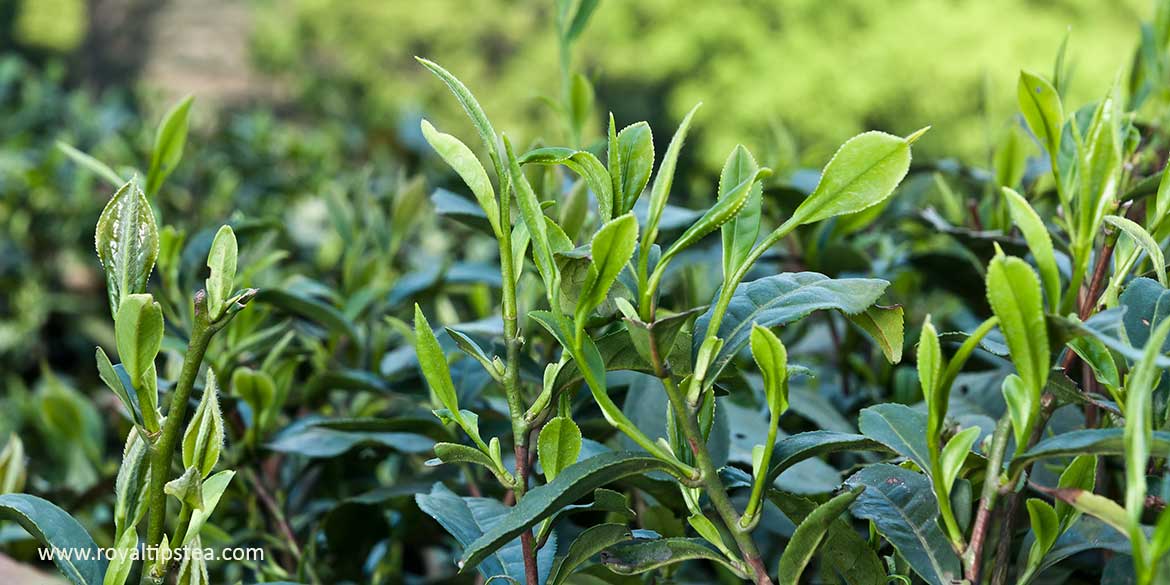
The post The flavours of tea first appeared on Blog Royal Tips.
]]>The post Why are Yixing teapots good to make tea? first appeared on Blog Royal Tips.
]]>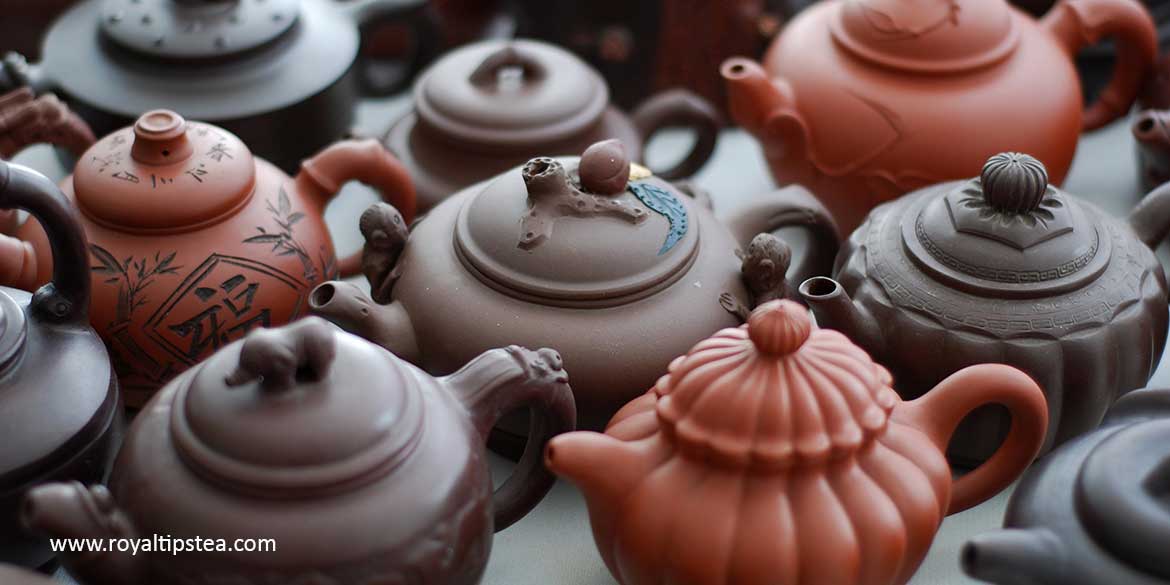
The quality of Yixing Zisha clay teapots
Unglazed earthenware Yixing teapots date back to the days of the Song Dynasty (960-1279 AD) and reached the height of their fame during the time of the Ming Emperors (1368–1644 AD). They are made in the town of Yixing (China), which lies close to Lake Tai in Jiangsu province, and the ‘zisha’ (purple) clay from the local hills has a special character and quality.
The colour of the zisha clay ranges from yellow and yellow-brown through red, red-brown, brown, purple-brown, green and black, and the mineral ingredients make it the best material for brewing loose leaf tea. Iron oxide gives the pots strength and an ability to maintain a stable temperature during brewing; other minerals – kaolinite, quartz, mica, hematite, and isinglass – make the teapot very porous and the tiny holes left in the pot after firing allow it to “breathe” during brewing and allow it to adapt to temperature changes during the brewing process. These characteristics help to draw out all the rich, complex layers of flavours from the tea.
What types of tea are brewed best in a Yixing pot?
Yixing teapot is never glazed for it is important that it remains porous. Yixing clay can be used for any type of tea but are particularly good for brewing Pu-erh teas and oolongs. Each zisha teapot should only be used for one particular type of tea (dark oolongs, cooked puerh, raw puerh, etc.) because the clay absorbs the tea oils as the leaves infuse. Each time the pot is used, extra layers of flavour are then added back into the water during brewing and give a smoothness and depth to the flavour of the tea. Some people prefer to use one individual pot not just for one category of teas but for just one individual tea – such as Mi Lan Dan Cong from Phoenix Mountains in China’s Guandong province, or Yan Cha rock oolong from the Wuyi Mountains.
Zisha teapot, a precios piece of Chinese art
Yixing teapots are always small and vary in size from a capacity of 70 ml to 225 ml. They can be very plain or are often made in the shape of other things – pumpkins, dragons, bundles of bamboo, turtles, a Buddhist priest, or a water lily pad topped with a little frog that forms the lid. And sometimes different clays are mixed to create a marbled effect. The teapots of high quality are made by hand, and skilled artists work the raw clay, craft and shape it by hand, cut the required pieces from slabs of the prepared clay, and mould them together to make the body. They then add the spout, the handle, the lid and any decorations on the surface.
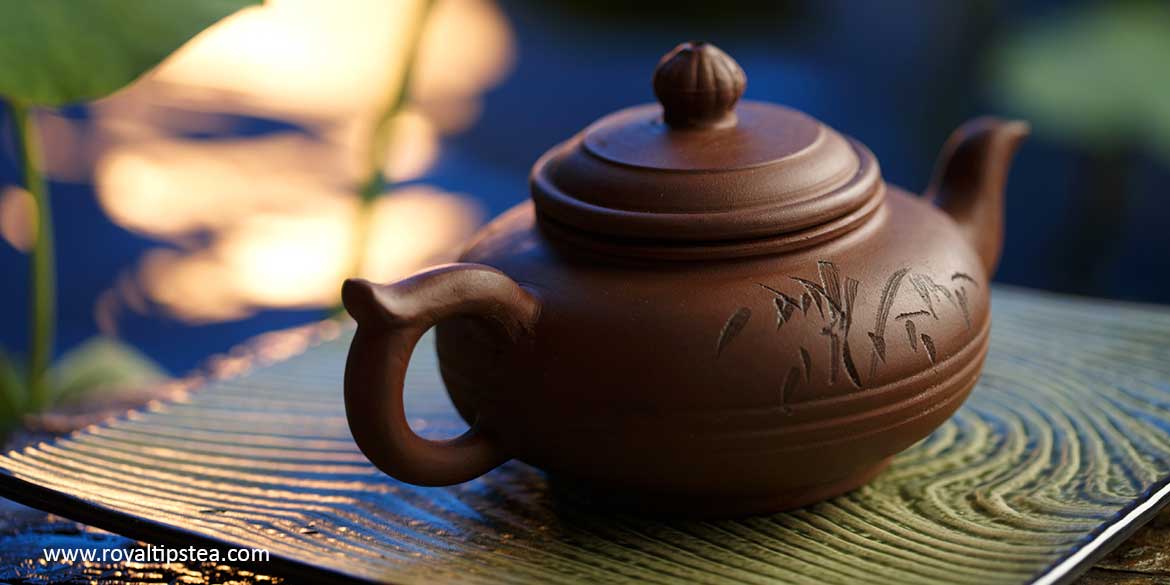
How to season a Yixing Teapot
When choosing a pot, think about the size you need for serving tea to, for example just one or two people, or to five or six people. Chose a shape and colour that pleases you and sits well with your other tea wares. Before using your pot to brew for the first time, you will need to season it.
1.Place the pot and lid in a large bowl or pan of cold water.
2. When it has soaked for a while, rub gently with a sponge of cloth that has no soap on it.
3. Using a mild, non-abrasive toothpaste and a toothbrush, scrub the pot all over to clean the surface thoroughly.
4. Rinse the pot in clean water.
5. Place the teapot and lid in a saucepan of clean cold water and place on the stove.
6. Bring the water to the boil and allow the pot and lid to remain in the gently simmering water for 10 0-15 minutes.
7. Carefully lift the teapot out of the water, drain and allow to cool. Do not plunge into cold water but allow to drain and cool naturally.
8. Pour some cold water into a pan and add a generous spoonful of dry leaves of the type of tea you plan to brew in the new pot. Bring the water and tea leaves to a gentle boil and carefully immerse the pot into the pan of tea. Switch off the heat, cover the pan and allow the pot to soak in the hot tea for at least 30 minutes or overnight.
9. Remove the pot from the pan, drain and allow to dry.
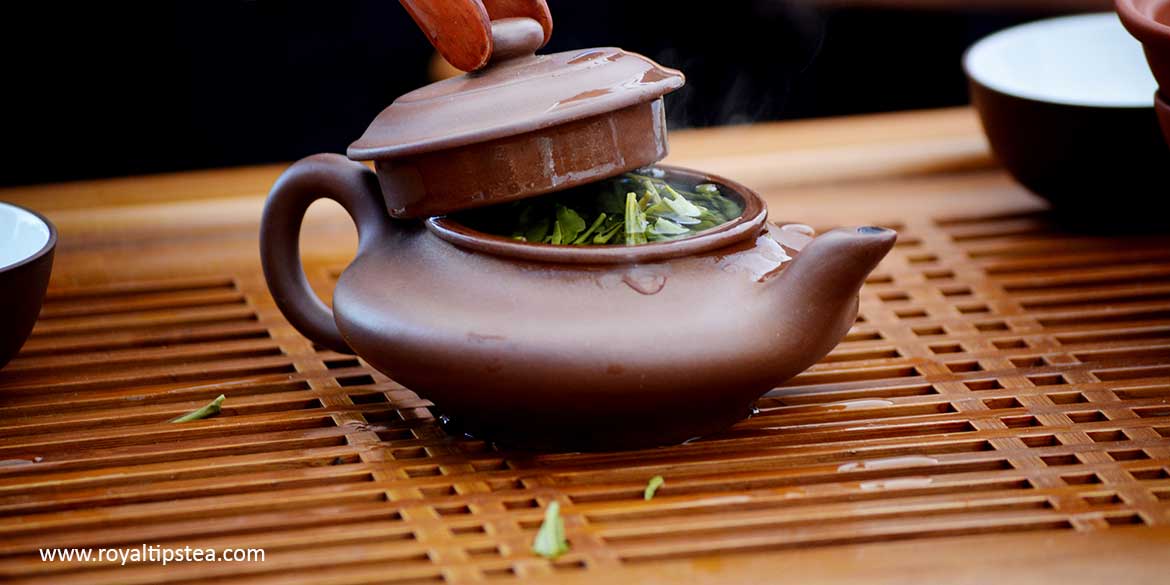
The post Why are Yixing teapots good to make tea? first appeared on Blog Royal Tips.
]]>